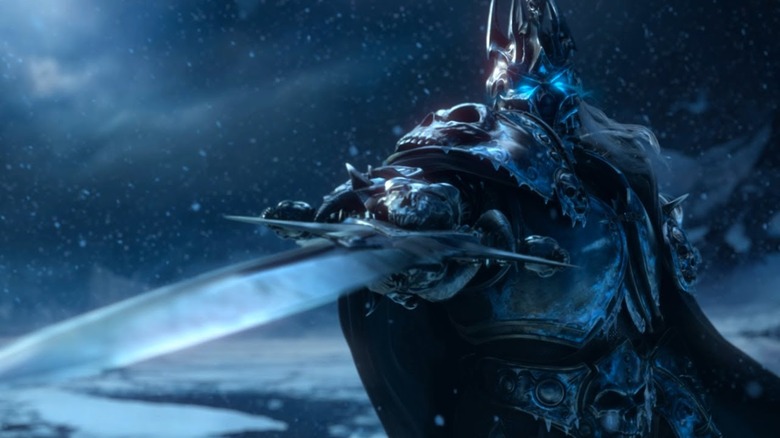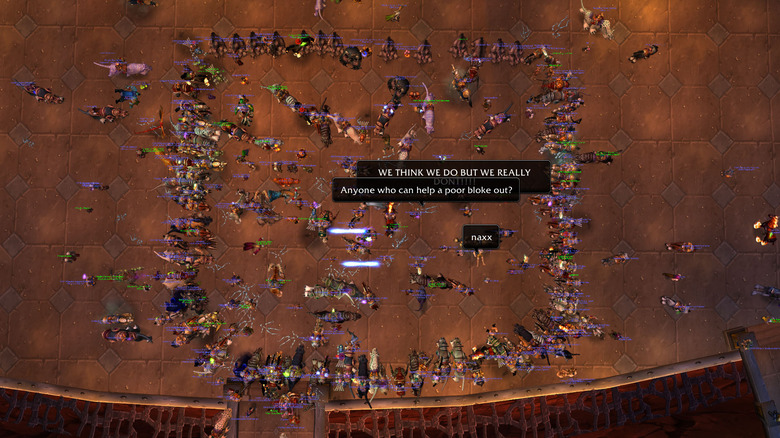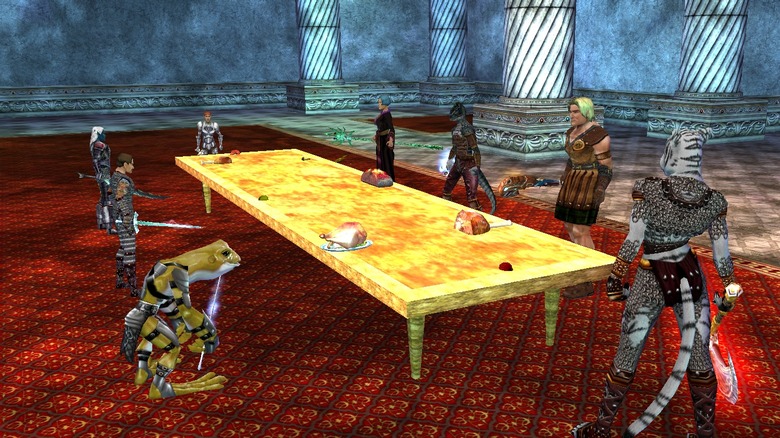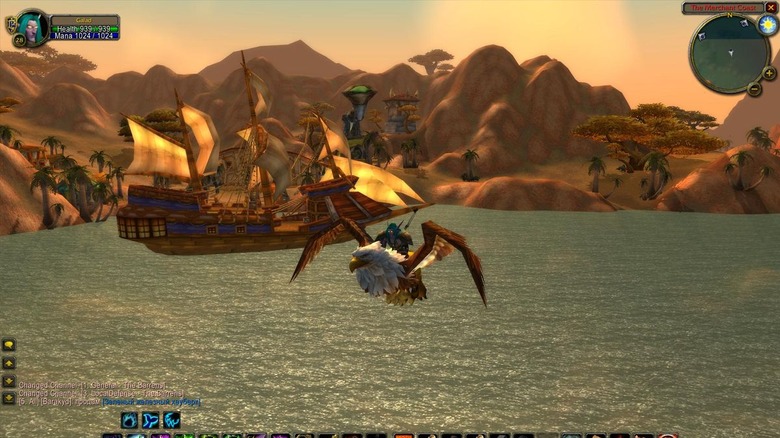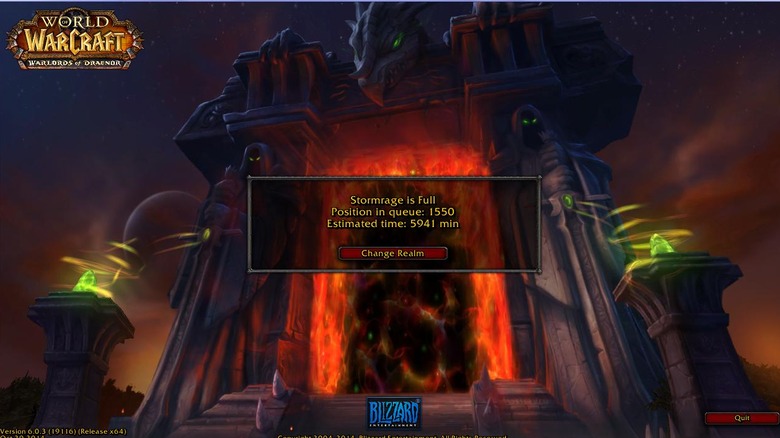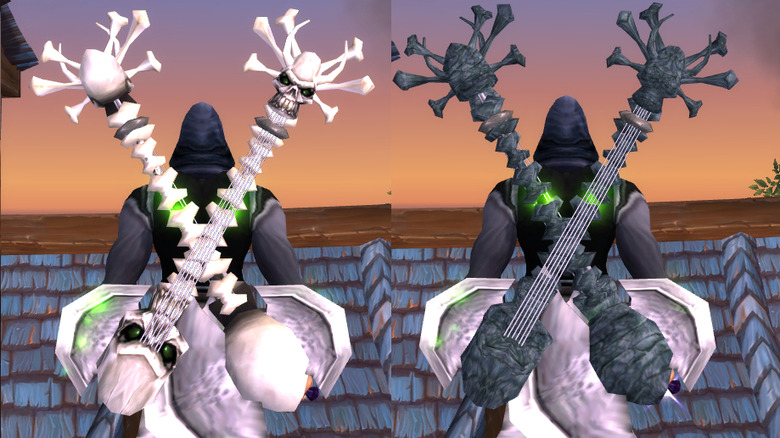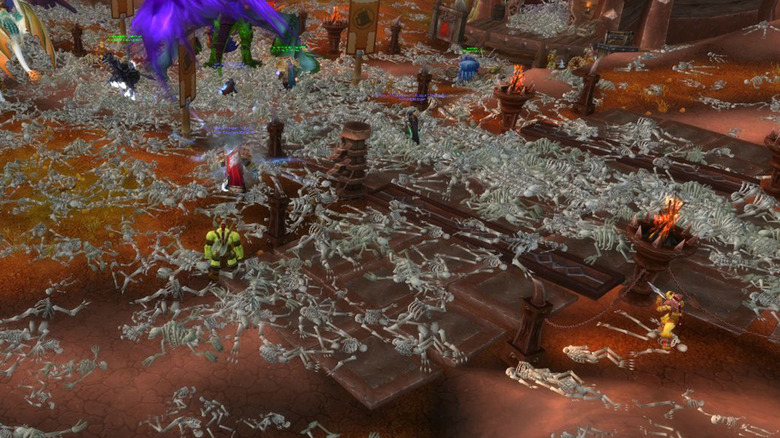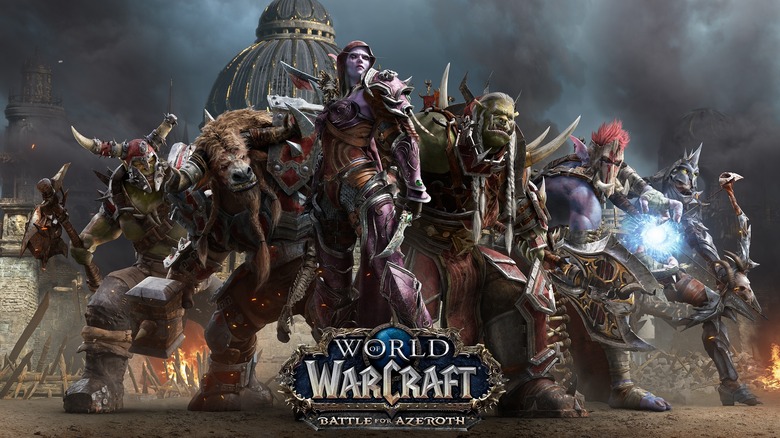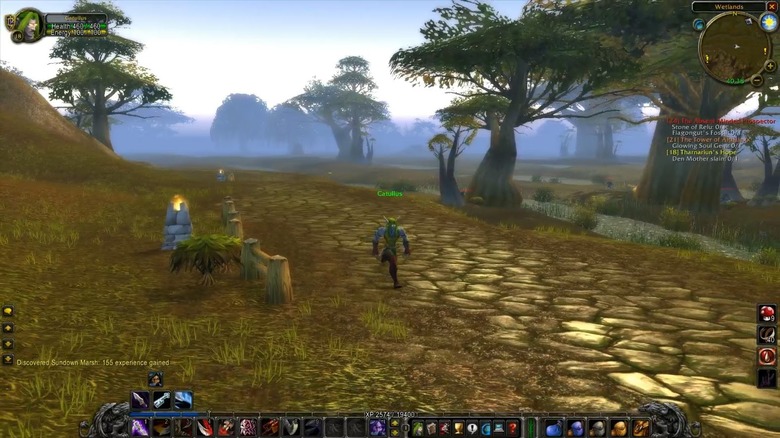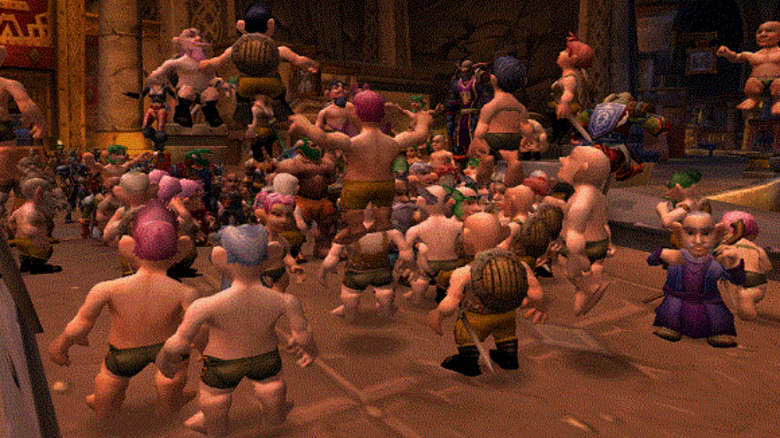The Untold Truth Of World Of Warcraft
World of Warcraft can make a serious claim as one of the most iconic PC games ever created. Blizzard has released a number of industry-changing titles over its storied history, with Diablo's incredible action-RPG innovations, StarCraft's real-time strategy perfection, and Overwatch's addictive multiplayer gameplay all standing out as highlights for a studio filled to the brim with accolades. Yet World of Warcraft's influence seems to be on another level: whether it's the celebrity endorsements, South Park spoof, or consistent reinvention of the title, it's a game that is simply peerless within its genre even fifteen years after its release.
World of Warcraft completely changed the massively multiplayer genre. Blizzard's careful attention to class balancing, constant content updates, and dedication to storytelling has created a multimedia empire that remains unassailable even as players around the world suggest that, surely, this year is the year that World of Warcraft finally begins its tumultuous downfall. And yet the game colloquially known as WoW doesn't appear to be going anywhere. Here, we'll be looking at some of the more obscure cornerstones of World of Warcraft, celebrating a decade-plus of fascinating stories and development.
Blizzard was worried they wouldn't hit 500,000 subscribers
World of Warcraft might seem like it was a sure thing in retrospect, but during its development, Blizzard wasn't that confident.
To be fair, on the business side, Blizzard had every right to worry. Blizzard was routinely pushing over a million in sales on their other games. At that point, the most successful MMO game of all time was EverQuest, a game that had never eclipsed 500,000 subscribers. Blizzard was also entering uncharted territory with the game, having primarily developed successful RTS titles like Warcraft and StarCraft. The closest analogy to an MMO they had? Diablo 2, an action-RPG released in 2000.
Chris Metzen, then the Senior Vice President, Story and Franchise Development at Blizzard, was quoted in an interview that the team believed hitting over a million subscribers within World of Warcraft's first year was "crazy talk." By all accounts, anxiety was running high in-studio leading up to the launch of Blizzard's next big project.
World of Warcraft eventually released towards the end of 2004. By the end of 2005, the game had already achieved 5 million concurrent subscribers, a feat that was unparalleled in the MMO genre — or any other, for that matter.
World of Warcraft's lead designer was a successful EverQuest guild leader
World of Warcraft might have changed the game as far as MMOs go, but it certainly found its inspiration in the genre's previous great: EverQuest.
That's not unusual, though. Prior to the release of WoW, EverQuest was the gold standard, with Ultima Online being the only real competitor to the crown. What is unusual is that World of Warcraft's lead designer, Rob Pardo, was actually a very successful EverQuest raider.
Pardo ran a guild called Legacy of Steel, a successful EverQuest raiding guild that required intense amounts of dedication to be a part of. Pardo developed an inherent understanding of what was needed in MMO games thanks to the way he navigated both the gameplay and social organization elements involved in running a guild, and that inevitably formed some of the improvements that World of Warcraft made to the systems that EverQuest had innovated.
Legacy of Steel actually has its fingerprints on a lot of what makes WoW a special game. Pardo recruited a guildmate named Jeff Kaplan to work on World of Warcraft with him, and Kaplan would eventually become an integral part of both that game and Overwatch. The next time you log on to Azeroth or snag a Play of the Game, say a little thank you to EverQuest for being the unexpected genesis for two of the talents that made World of Warcraft and Overwatch so compelling.
Rested experience prevented player burnout
World of Warcraft is, appropriately, a massive game. The amount of decision-making that goes into how a raid is designed, where quests are given and turned in, and how players level up their character must be mind-boggling. Even some of the mechanics of the game that seem like afterthoughts were designed very deliberately.
The rested experience system in World of Warcraft is relatively straightforward: players who log off in designated safe areas like towns begin to accumulate a rested experience pool, increasing the amount of experience they earn the next time they log on for a set amount of time. The longer players log off, the more rested experience they accumulate for their next session.
That system wasn't just designed as a neat little bonus to get player's to return to the towns Blizzard worked so hard to design, though. Pardo spearheaded the rested experience concept as a way to prevent player burnout after Blizzard noticed people were literally never logging off. Some people would share a single character and alternate who was playing it at a given time, creating a treadmill-like effect that Pardo wasn't keen on.
Originally, players would begin earning half the usual experience points for a given action after being logged on for a certain amount of time, but gamers hated it. Pardo's idea to make it a bonus instead created a much better incentive to log off for periods of time, and helped combat player burnout in a big way.
After launch, the game teetered on unplayable
Blizzard had no way of anticipating that World of Warcraft would be so big at launch. As more players began to spill into Azeroth, a huge number of issues arose that threatened the game's long-term viability.
Thousands of players attempting to loot items at once would create a strain on the items database of the game, causing characters to get locked into a crouch animation. That glitch had two known fixes: wait upwards of ten minutes for the lag to dissolve, or log out and log back in.
The latter solution to loot lag had its own issues, though. Players would routinely wait half an hour in queues to log in, only to be kicked out by server latency issues shortly after. Logging out to try and fix anything else was just too risky.
The worst offender in the early days of launch were the realm rollbacks, though. Blizzard had to combat the failing tech side of World of Warcraft somehow, and resetting realms was the solution. The issue was that it would also delete the past several minutes of every players' game actions – meaning someone who had finally gotten rare loot might have it taken from them for seemingly no reason.
World of Warcraft was a mess in its earliest days, and it's a testament to the quality of the game that so many players suffered through these issues just to spend time in Azeroth.
World of Warcraft is a very different experience in China
World of Warcraft typically fails to make much of an impact in most country's ratings boards, given its cartoony graphics, whimsical questing and lack of any real gore or sexuality. That hasn't stopped China from hammering Blizzard hard with requests for censorship for the parts of the game that get a little bit grimmer, however.
World of Warcraft was once down for three weeks while Blizzard changed Chinese operators. The reason for that wasn't known at first, but was later confirmed once the game finally returned: local Chinese authorities had an issue with certain representations within the game, and decided to censor them.
In what's become something of a norm now with Chinese releases of the game, blood is recolored to either black or green, Undead characters have their bones covered up and look much more alive, any representations of bones are removed or colored over, and piles of bones in the world map are reskinned to become ... sandbags. The Lich King obviously didn't want to slip on his way out the door in Northrend.
Chinese fans have also had to deal with massive expansion delays. While the rest of the world was enjoying Wrath of the Lich King in November 2008, China had to wait until August 2010. That's nearly a two year wait for an expansion, which was held up despite being submitted in September 2009 over content concerns.
The rarest mount in the game was owned by exactly one player
A lot of what we know about this is based on rumor and hearsay; many of the original posts regarding it have been lost to time. What we do know for sure is that the Fluorescent Green Mechanostrider existed at one point in time, and that it was owned by one player.
That player is Narshe, from Frostmourne EU's server, and they are the genesis of what would become the Legend of the Fluorescent Green Mechanostrider. According to rumor, Narshe accidentally deleted their mount and requested a new one from a GM. The GM obliged, but mistakenly gave Narshe a mount that had not been released in-game. While the Mechanostrider existed, it could be seen in the EU Armory, proving that it was more than an urban legend.
Unfortunately, however, the tale of the Mechanostrider takes a sad turn after that. Perhaps Narshe was blinded by being a celebrity in Azeroth, or the siren call of real-world money was just too sweet to resist, but all signs point to Narshe attempting to sell the Mechanostrider, and their account, illegally.
Naturally, World of Warcraft's GMs don't look too kindly upon these kinds of transgressions. Narshe still exists, but the Fluorescent Green Mechanostrider has been removed from their inventory and has never appeared since, making it the rarest mount in the game — and one that, barring a miracle, no one will ever possess again.
The Corrupted Blood incident was actually studied by researchers
If you haven't figured it out by now, early World of Warcraft was a weird, wild place. Perhaps nothing better embodies that timeframe than the Corrupted Blood Incident, a mistake in game code that ravaged populations on Azeroth in 2005.
Corrupted Blood was a debuff given to players by Hakkar The Soulflayer, a dungeon boss in Zul'Gurub. The disease inflicted damage over time to anyone afflicted by it, and could be spread to other characters in close proximity. Given that the dungeon was high-level at the time, it was more of an inconvenience than anything life-threatening for well-prepared groups.
The problem came with the way it was coded. Thanks to Hunter pets and teleportation abilities, the Corrupted Blood debuff made its way out of the instance, which was never intended. What happened next was the utter decimation of World of Warcraft to a virtual pandemic, which spread to major cities and completely demolished swaths of the population as players split into camps trying to heal what was happening and those attempting to spread it.
The Corrupted Blood Incident wasn't just a cool accident, though: it was a valuable look into the human psyche for health officials and researchers. The incident so accurately simulated a pandemic that studies were done to gain insight into how humanity might respond to something similar in the real world. World of Warcraft: potentially saving lives while consuming them!
World of Warcraft is still breaking sales records in 2018
For those who haven't been paying attention to World of Warcraft, the lazy narrative over the past five or so years have been that the game's best days are behind it. While that may have been true of the Warlords of Draenor expansion, which was pretty poorly received, it's been all upside for Blizzard since then.
In fact, the most recent expansion, Battle for Azeroth, actually broke a sales launch record for Blizzard, showing that World of Warcraft is still going strong today. Even more interesting? That launch record was actually held by Legion, the expansion that immediately precedes Battle for Azeroth. Legion moved around 3.3 million copies, while Battle for Azeroth edged ahead with 3.4 million copies sold in its first day available.
Blizzard has stopped reporting subscription numbers for World of Warcraft, in part due to the player base panic that lower figures can incite. It might be difficult to ascertain what World of Warcraft's long-term health looks like as a result of that secrecy, but at least as far as expansion launches are concerned, World of Warcraft has actually never been doing better. There's a reason the MMO genre has been so stagnant over the past decade or so: years later, Blizzard is still doing it best.
You don't even remember how clunky vanilla WoW was
Ever wonder just how big an influence nostalgia can be on your perception of your favorite games? Just ask World of Warcraft fans, who are caught between wanting the upcoming Classic version of the game to be a perfect recreation of what it once was and something of an upgrade to the vanilla content.
To us, the latter option is where the smart money is. World of Warcraft's vanilla days were unbelievably clunky, and quality of life upgrades since then have made the game much more manageable and enjoyable. The designers behind World of Warcraft Classic even went on record as saying that they didn't really remember just how clunky everything was until they jumped back in to figure out how to approach the return to old school WoW.
Need some examples? The Night Elf pilgrimage from Menethil Harbor to Ironforge used to be anywhere between 15 to 45 minutes long, taking players through zones well above their player level and frustrating them to no end. That's with no mount, of course. There's also the painful process of buffing teammates in raids, which would involve using a buff, sitting down, drinking to regain mana, standing back up, casting another spell on someone else, then repeating the process ad nauseam.
Trust us, World of Warcraft's elder days might be appealing through the lens of nostalgia, but some things are better left unearthed — or, at the very least, redesigned.
Players once organized a protest called the Million Gnome March
Just like Azeroth had been the site of pandemic research, art imitated life once more when a group of players banded together to protest balance changes made in beta and early launch days. Vanilla World of Warcraft was not the mostly-balanced masterpiece that the game is today. In beta, Warriors received significant nerfs that made them go from one of the most powerful classes to much more even with others, something that a significant contingent of players were quite unhappy with. Then, post-launch, Warriors were nerfed again, seemingly for no reason.
Fed up with what they perceived to be gross misjudgment on Blizzard's part, a group of players organized the Million Gnome March. People created a level 1 Gnome character on the Argent Dawn realm and marched to Ironforge together. With so many players in the same place at the same time, the server started to lag, making the realm experience much worse. GMs got involved, asking protestors to leave the area. When they refused, a GM threatened to suspend players' accounts if they continued their mostly-naked protest. Most players logged off and the protest fizzled out from there, but Warriors had made their cause known.
Funnily enough, nothing ever came from the protests. Warriors enjoyed some of the most success in vanilla WoW despite their complaints, and Blizzard never felt compelled to make serious changes to the class.

